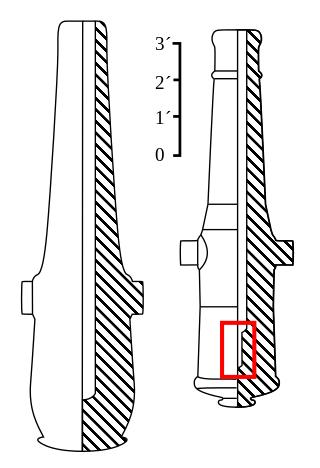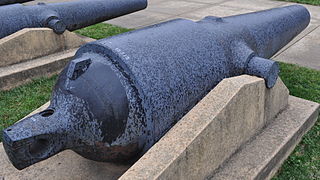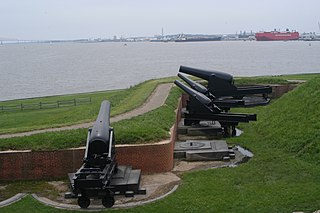
The Battle of Fort Sumter was the bombardment of Fort Sumter near Charleston, South Carolina, by the South Carolina militia. It ended with the surrender of the fort by the United States Army, beginning the American Civil War.

The Rodman gun is any of a series of American Civil War–era columbiads designed by Union artillery officer Thomas Jackson Rodman (1815–1871). The guns were designed to fire both shot and shell. These heavy guns were intended to be mounted in seacoast fortifications. 8-inch, 10-inch, 13-inch, 15-inch, and 20-inch bore Rodman guns were produced. Other than size, the guns were all nearly identical in design, with a curving bottle shape, a large flat cascabels, and ratchets or sockets for the elevating mechanism. Rodman guns were true guns that did not have a howitzer-like powder chamber, as did many earlier columbiads. Rodman guns differed from all previous artillery because they were hollow cast, a new technology that Rodman developed that resulted in cast-iron guns that were much stronger than their predecessors.

Fort Moultrie is a series of fortifications on Sullivan's Island, South Carolina, built to protect the city of Charleston, South Carolina. The first fort, formerly named Fort Sullivan, built of palmetto logs, inspired the flag and nickname of South Carolina, as "The Palmetto State". The fort was renamed for the U.S. patriot commander in the Battle of Sullivan's Island, General William Moultrie. During British occupation, in 1780–1782, the fort was known as Fort Arbuthnot.

The Parrott rifle was a type of muzzle-loading rifled artillery weapon used extensively in the American Civil War.

The Brooke rifle was a type of rifled, muzzle-loading naval and coast defense gun designed by John Mercer Brooke, an officer in the Confederate States Navy. They were produced by plants in Richmond, Virginia, and Selma, Alabama, between 1861 and 1865 during the American Civil War. They served afloat on Confederate ships and ashore in coast defense batteries operated by the Confederate States Army.

The First Battle of Fort Wagner was fought on July 10 and 11, 1863, on Morris Island in Charleston harbor during the American Civil War. An attempt by the Union Army to capture Fort Wagner was repulsed. The more famous Second Battle of Fort Wagner, which involved an assault by the 54th Massachusetts, would be fought on July 18.

Fort Morgan is a historic masonry pentagonal bastion fort at the mouth of Mobile Bay, Alabama, United States. Named for American Revolutionary War hero Daniel Morgan, it was built on the site of the earlier Fort Bowyer, an earthen and stockade-type fortification involved in the final land battles of the War of 1812. Construction was completed in 1834, and it received its first garrison in March of the same year.

Field artillery in the American Civil War refers to the artillery weapons, equipment, and practices used by the artillery branch to support infantry and cavalry forces in the field. It does not include siege artillery, use of artillery in fixed fortifications, coastal or naval artillery. It also does not include smaller, specialized artillery pieces classified as infantry guns.

The columbiad was a large-caliber, smoothbore, muzzle-loading cannon able to fire heavy projectiles at both high and low trajectories. This feature enabled the columbiad to fire solid shot or shell to long ranges, making it an excellent seacoast defense weapon for its day. Invented by Colonel George Bomford, United States Army, in 1811, columbiads were used in United States seacoast defense from the War of 1812 until the early years of the 20th century. Very few columbiads were used outside of the U.S. and Confederate Armies; nevertheless, the columbiad is considered by some as the inspiration for the later shell-only cannons developed by Frenchman Henri-Joseph Paixhans some 30 years later.

The siege of Fort Pulaski concluded with the battle of Fort Pulaski fought April 10–11, 1862, during the American Civil War. Union forces on Tybee Island and naval operations conducted a 112-day siege, then captured the Confederate-held Fort Pulaski after a 30-hour bombardment. The siege and battle are important for innovative use of rifled guns which made existing coastal defenses obsolete. The Union initiated large-scale amphibious operations under fire.

The Second Battle of Charleston Harbor, also known as the Siege of Charleston Harbor, the Siege of Fort Wagner, or the Battle of Morris Island, took place during the American Civil War in the late summer of 1863 between a combined U.S. Army/Navy force and the Confederate defenses of Charleston, South Carolina.

Seacoast defense was a major concern for the United States from its independence until World War II. Before airplanes, many of America's enemies could only reach it from the sea, making coastal forts an economical alternative to standing armies or a large navy. Substantial fortifications were built at key locations, especially protecting major harbors. Seacoast defense also included submarine minefields, nets and booms, ships, and, later, airplanes. The U.S. Army Corps of Engineers played the central role in constructing fixed defenses, but all of the armed forces participated.

James rifle is a generic term to describe any artillery gun rifled to the James pattern for use in the American Civil War, as used in some period documentation. Charles T. James developed a rifled projectile and rifling system. Modern authorities such as Warren Ripley and James Hazlett have suggested that the term "James rifle" only properly applies to 3.8 in (97 mm) bore field artillery pieces rifled to fire James' projectiles. They contend that the term does not apply to smoothbores that were later rifled to take the James projectiles in 3.67 in (93 mm) caliber or other calibers, and that those should instead be referred to as "Rifled 6 pounder", etc. The rifle was created in 1861.
Blakely rifle or Blakely gun is the name of a series of rifled muzzle-loading cannon designed by British army officer Captain Theophilus Alexander Blakely in the 1850s and 1860s. Blakely was a pioneer in the banding and rifling of cannon but the British army declined to use Blakely's design. The guns were mostly sold to Russia and the Confederacy during the American Civil War. Blakely rifles were imported by the Confederacy in larger numbers than other Imported English cannon. The State of Massachusetts bought eight 9 in (23 cm) and four 11 in (28 cm) models.

Sylvanus Sawyer was a United States inventor.

The 3-inch ordnance rifle, model 1861 was a wrought iron muzzleloading rifled cannon that was adopted by the United States Army in 1861 and widely used in field artillery units during the American Civil War. It fired a 9.5 lb (4.3 kg) projectile to a distance of 1,830 yd (1,670 m) at an elevation of 5°. The 3-inch rifle was not as effective in firing canister shot as the heavier 12-pounder Napoleon, but it proved to be highly accurate at longer ranges when firing common shell or spherical case shot. There was only one reported case of a 3-inch ordnance rifle bursting in action. This was in stark contrast to the similarly-sized cast iron 10-pounder Parrott rifles which occasionally burst without warning, inflicting injury on the gun crews. The Confederate States of America lacked the technology to manufacture reliable copies of the 3-inch ordnance rifle. However, the Confederate States Army respected the weapons and employed those captured from Federal forces.

Fort Slocum was one of seven temporary earthwork forts, part of the Civil War Defenses of Washington, D.C., during the Civil War, built in the Northeast quadrant of the city after the beginning of the war by the Union Army to protect the city from the Confederate Army. From west to east, the forts were as follow: Fort Slocum, Fort Totten, Fort Slemmer, Fort Bunker Hill, Fort Saratoga, Fort Thayer and Fort Lincoln.

The 10-pounder Parrott rifle, Model 1861 was a muzzle-loading rifled cannon made of cast iron that was adopted by the United States Army in 1861 and often used in field artillery units during the American Civil War. Like other Parrott rifles, the gun breech was reinforced by a distinctive band made of wrought iron. The 10-pounder Parrott rifle was capable of firing shell, shrapnel shell, canister shot, or solid shot. Midway through the war, the Federal government discontinued the 2.9 in (74 mm) version in favor of a 3.0 in (76 mm) version. Despite the reinforcing band, the guns occasionally burst without warning, which endangered the gun crews. The Confederate States of America manufactured a number of successful copies of the gun.

The 20-pounder Parrott rifle, Model 1861 was a cast iron muzzle-loading rifled cannon that was adopted by the United States Army in 1861 and employed in field artillery units during the American Civil War. As with other Parrott rifles, the gun breech was reinforced by a distinctive wrought iron reinforcing band. The gun fired a 20 lb (9.1 kg) projectile to a distance of 1,900 yd (1,737 m) at an elevation of 5°. The 20-pounder Parrott rifle could fire shell, shrapnel shell, canister shot, and more rarely solid shot. In spite of the reinforcing band, the 20-pounder earned a dubious reputation for bursting without warning, killing or injuring gunners. The Confederate States of America also manufactured copies of the gun.























































